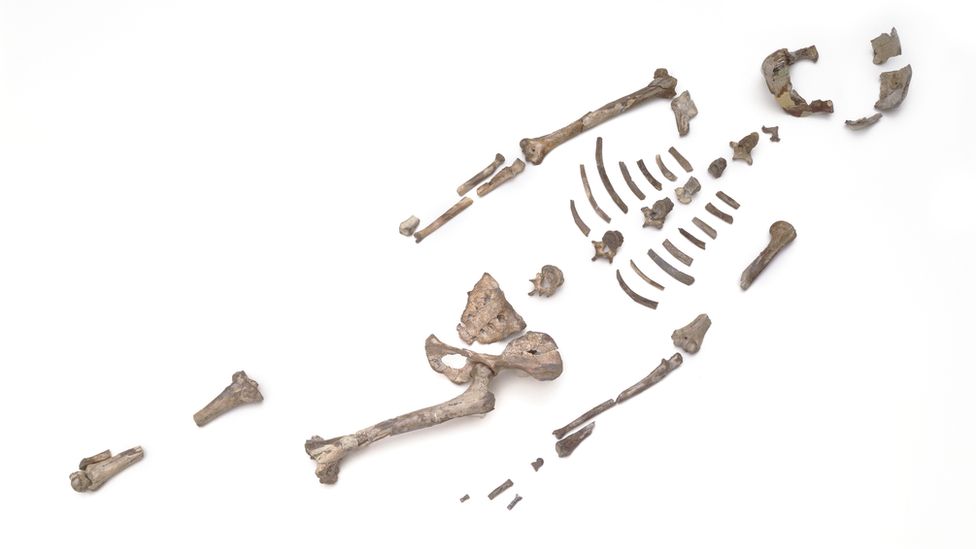Early human ancestor Lucy 'died falling out of a tree'
- Published

New evidence suggests that the famous fossilised human ancestor dubbed "Lucy" by scientists died falling from a great height - probably out of a tree.
CT scans have shown injuries to her bones similar to those suffered by modern humans in similar falls.
The 3.2 million-year-old hominin was found on a treed flood plain, making a branch her most likely final perch.
It bolsters the view that her species - Australopithecus afarensis - spent at least some of its life in the trees.
Writing in the journal Nature, researchers from the US and Ethiopia describe a "vertical deceleration event" which they argue caused Lucy's death.
In particular they point to a crushed shoulder joint, of the sort seen when we humans reach out our arms to break a fall, as well as fractures of the ankle, leg bones, pelvis, ribs, vertebrae, arm, jaw and skull.
"We weren't there - we didn't see it - but the subset of fractures that we've identified are fully consistent with what's reported in a voluminous orthopaedic surgical literature about fall victims who have come down from height," said lead author John Kappelman from the University of Texas at Austin.
"It's tested every day in emergency rooms all around the planet."
Discovered in Ethiopia's Afar region in 1974, Lucy's 40%-complete skeleton is one of the world's best known fossils. She was around 1.1m (3ft 7in) tall and is thought to have been a young adult when she died.
Her species, Australopithecus afarensis, shows signs of having walked upright on the ground and had lost her ancestors' ape-like, grasping feet - but also had an upper body well-suited to climbing.
Window of opportunity
The bones of this well-studied skeleton are in fact laced with fractures, like most fossils. But with modern tools such as high-resolution CT scanners, researchers can start to unpick which ones were injuries and which ones happened during the intervening millennia.
"These fractures have been known since she was discovered," Prof Kappelman told BBC News. "I've looked at this fossil for 30 years and I knew that these fractures were there."
It was during a brief break in Lucy's 2008 tour of US museums that he and his colleagues found time for the scans.
"We were able to get permission from the Ethiopian government… and after the exhibit closed down in Houston, we brought Lucy here to the UT campus - in secret, for security purposes. And we have a high-resolution CT scan here.
"We scanned everything. We worked 24/7, 10 days straight without a break."
Without those precious scans, Prof Kappelman said, Lucy's injuries would never have come to light.
"What it allows us to do is literally look inside mineralised rocks and bones. And Lucy - as much as we love her - she's a rock. She's fully mineralised."
Serious trauma
By peering inside the bones in minute detail, the scanner showed that several of the fractures were "greenstick" breaks. The bone had bent and snapped like a twig: something that only happens to healthy, living bones.
So the injuries happened while Lucy was alive - but they also show no signs of healing, so these misfortunes apparently befell the small creature at the very time of her death.
A fatal fall also fits with the fact that Lucy's tiny first rib is broken. This bone is small and heavily protected, Prof Kappelman explained; if it's fractured, you're having a bad day.
"When you look at rib fractures, the first rib is the most rarely fractured. It take a high amount of chest trauma."
But the shattered top of the fossilised humerus bone - Lucy's upper arm - is the most compelling piece of the puzzle.
"If our hypothesis stands up… it tells us that Lucy was conscious when she reached out her arms to break her fall," said Prof Kappelman.
The researchers even used their scans to 3D print Lucy's humerus and discuss it with orthopaedic surgeons. So far, they have all agreed.
"At this point I'm nine from nine," Prof Kappelman said of his blind tests on unsuspecting bone doctors, adding that he printed out the bones in an enlarged form so that they appeared human.
"Everybody agrees this is a fall from height."
In fact, 3D printing is now something that anyone with an interest in Lucy can do. The researchers, in partnership with the government of Ethiopia, have made the files available online.
"The Ethiopian ministry has agreed to release 3D files of Lucy's right shoulder and her left knee. So anyone with an interest in this can print Lucy out and evaluate these fractures, and our hypothesis, for themselves."
'Perfectly plausible'
Nancy Lovell, a professor of anthropology at the University of Alberta in Canada, commented that the fracture findings were surprising but convincing.
"It seems fantastical but there's nothing to contradict their interpretation," she told the BBC. "And their use of really good, computerised imaging helps.
"Taken individually, the pieces all look perfectly plausible."
Prof Lovell is uncertain about the precise height and speed of the fall, which the Texas-led team estimated at 12m (40ft) and 60km/h (35mph).
"People die from falls. People fall off ladders and die of head injuries - it doesn't have to have been a really tall tree," she said.
"[But] we certainly think the area where she was living was treed at the time."
Prof Chris Stringer, from London's Natural History Museum, said the idea of a tree fall was a good fit with our understanding of how Australopithecus afarensis lived.
"They could have been in trees some of the time for feeding, nesting, or protection," he said.
"If Lucy had young, for example, trees would certainly have been a safer option than the ground when predators were around."
Follow Jonathan on Twitter
- Published28 May 2015
- Published10 February 2011